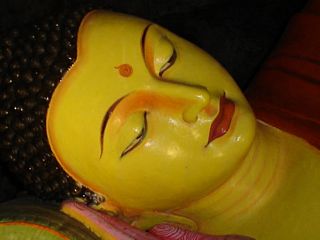ReferenceMapsAudio

ABT HomeOriginal TextsTexts & TranslationsEnglishProsody
ReferenceMapsAudio
you must use diacritics when searching
Texts and Translations Home Page
Mahāparinibbānasuttaṁ
The Discourse about the Great Emancipation (DN 16)
edited and translated by
Ānandajoti Bhikkhu
(first published, July 2008)
different version of the work:
English Only
with a reading of the translation

eBooks
Html Table of Contents (outline)
The First Chapter for Recitation
The Second Chapter for Recitation
The Third Chapter for Recitation
The Fourth Chapter for Recitation
The Fifth Chapter for Recitation
The Sixth Chapter for Recitation
Html Table of Contents (detail)
The First Chapter for Recitation
2: Seven Things which Prevent Decline in the Vajjians
3: Seven Things which Prevent Decline in the Community (1-7)
4: Seven Further Things which Prevent Decline in the Community (8-14)
5: Seven Further Things which Prevent Decline in the Community (15-21)
6: Seven Further Things which Prevent Decline in the Community (22-28)
7: Seven Further Things which Prevent Decline in the Community (29-35)
8: Six Things which Prevent Decline in the Community (36-41)
9: The Story of the Teaching at Ambalaṭṭhikā
The Second Chapter for Recitation
14: The Mirror of (the True Nature of) Things
16: The Gracious One's Sickness
The Third Chapter for Recitation
18: The Relinquishment of the Life Process
19: Eight Reasons for Earthquakes
21: The Eight Means of (Mind) mastery
24: Ānanda's Fault at Rājagaha
26: The Thirty-Seven Things on the Side of Awakening
The Fourth Chapter for Recitation
31: The Story concerning Pukkusa Mallaputta
The Fifth Chapter for Recitation
33: Worshipping the Realised One
34: The Visit of the Divinities
35: The Four Places that Produce Enthusiasm
36: Ānanda's Marvellous Qualities
38: The Mallas Worship the Gracious One
39: Subhadda, the Last Direct Disciple
The Sixth Chapter for Recitation
40: The Last Instructions of the Realised One
42: The Preparation of the Body
(BJT): Śrī Laṁkan edition, from the Buddha Jayanti Tripitaka Series, Volume VIII (Colombo, 1976/2519, reprinted with corrections 2005).
(Thai): Thai edition, as found on Budsir for Windows CD-ROM (version 2.0, Bangkok, 1996).
(ChS): Burmese edition, as found on the Chaṭṭha Saṅgāyana CD-ROM (version 3), Igatpuri (no date, but = 1999).
(PTS): European edition, The Dīgha Nikāya, ed. T.W. Rhys Davids and J. Estlin Carpenter, (1903, reprinted 1995).
* * *
(Comm): Mahāparinibbānasuttavaṇṇanā, as found on the Chaṭṭha Saṅgāyana CD-ROM (version 3), Igatpuri (no date, but = 1999).
Translations Consulted
The Book of the Great Decease, in Dialogues of the Buddha, Vol II, by T.W. and C.A.F. Rhys Davids (Pali Text Society, 1910, 4th edition reprinted 1995, Oxford).
The Buddha's Last Days, from The Long Discourses of the Buddha, a translation of the Dīgha Nikāya, by Maurice Walshe (Wisdom Publications, Boston, 1995).
Last Days of the Buddha, translated from the Pali by Sister Vajira & Francis Story (Buddhist Publication Society, Kandy, Sri Lanka, 2007).
* * *
The Buddha's Last Days, Buddhaghosa's Commentary on the Mahāparinibbāna Sutta, translated by Yang-Gyu An (Pali Text Society, 2005, Oxford).
In preparing this text and translation for publication I have divided it into a number of versions. In the Buddhist Texts and Studies section will be found the Pāḷi Text together with the variant readings. This is a more technical work dealing with the establishment of the text, and considers the text from the point of view of its grammar, prosody, and how the material has been collected.
In the Texts and Translations section I present the full Text and Translation with annotations which help to explain matters that may not be clear from the text itself. I have therefore translated sections from the Commentary, added notes on the history and geography, and explained points of doctrine whenever it seemed necessary.
In the English section there is the Translation Only, with somewhat less notes than in the Text and Translations section, which is intended for the casual reader who wants a reliable translation but is not interested in the technical matters concerning the original text itself.
The Text and Translation also has an Introduction which gives an outline of the text and discusses certain issues regarding its chronology; and the Pāḷi Text has a study of the Establishment of the Text, and the additions that have been made to it.
I am very grateful to Dhammacārī Chittapāla for reading through the translation and making many valuable corrections and suggestions for improvement, his knowledge of Pāḷi and the teaching, and his willingness to help with this work, are greatly appreciated. If anyone else has any corrections please let me know at anandajoti@gmail.com.
Ānandajoti Bhikkhu
July 2008